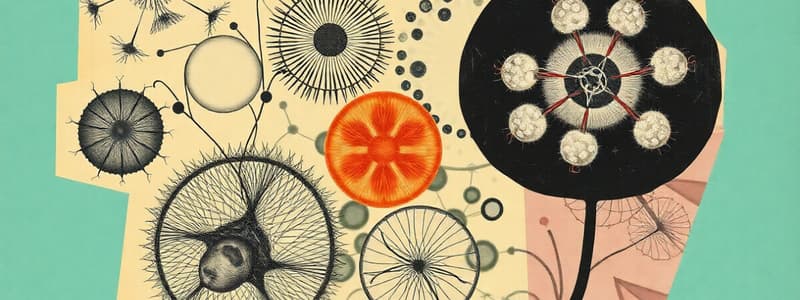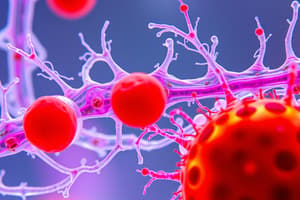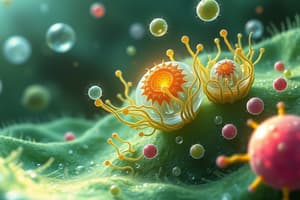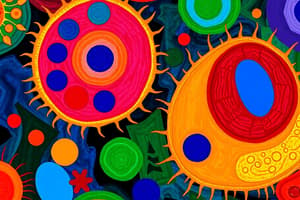Podcast
Questions and Answers
Why were early scientists unable to observe cells directly?
Why were early scientists unable to observe cells directly?
- Early scientists lacked the knowledge of cell staining techniques.
- Cells did not exist before the invention of advanced microscopes.
- Cells are too small to be seen with the naked eye and require a microscope. (correct)
- The technology to prepare samples for observation was not yet developed.
Robert Hooke used the term 'cellula' to describe the structures he observed. What is the meaning of 'cellula'?
Robert Hooke used the term 'cellula' to describe the structures he observed. What is the meaning of 'cellula'?
- A small compartment (correct)
- A type of tissue
- A liquid substance
- A complex network
Which of the following statements correctly differentiates between unicellular and multicellular organisms?
Which of the following statements correctly differentiates between unicellular and multicellular organisms?
- Unicellular organisms perform fewer life functions than multicellular organisms.
- Multicellular organisms are always microscopic, while unicellular organisms are macroscopic.
- Multicellular organisms do not need to perform respiration, unlike unicellular organism.
- Unicellular organisms are composed of one cell, while multicellular organisms are composed of many cells. (correct)
How does a nerve cell's shape relate to its function?
How does a nerve cell's shape relate to its function?
What is the approximate size range of typical cells?
What is the approximate size range of typical cells?
When observing cheek cells under a microscope, what stain is typically used to enhance the visibility of cellular structures?
When observing cheek cells under a microscope, what stain is typically used to enhance the visibility of cellular structures?
In the experiment observing leaf cells, what specific structure within the cell is made more visible with the addition of saffron stain?
In the experiment observing leaf cells, what specific structure within the cell is made more visible with the addition of saffron stain?
What is the primary reason for covering a sample with a coverslip when preparing a slide for microscopic observation?
What is the primary reason for covering a sample with a coverslip when preparing a slide for microscopic observation?
Which of the following is the most accurate process for observing blood cells under a microscope?
Which of the following is the most accurate process for observing blood cells under a microscope?
What is the correct conversion of 0.3 micrometers ($\mu m$) to meters?
What is the correct conversion of 0.3 micrometers ($\mu m$) to meters?
Flashcards
Cells
Cells
Basic units of structure and function in living organisms.
Unicellular Organism
Unicellular Organism
An organism consisting of one cell.
Multicellular Organism
Multicellular Organism
An organism consisting of many cells.
Robert Hooke
Robert Hooke
Signup and view all the flashcards
Nerve Cells
Nerve Cells
Signup and view all the flashcards
Microscope
Microscope
Signup and view all the flashcards
Cell Structures
Cell Structures
Signup and view all the flashcards
Plant Cell
Plant Cell
Signup and view all the flashcards
Red Blood Cells
Red Blood Cells
Signup and view all the flashcards
White Blood Cells
White Blood Cells
Signup and view all the flashcards
Study Notes
Introduction to Cells
- Cells are covered in detail
- The channel provides videos for commerce subjects, accessible via the DAV School search on YouTube.
- All living organisms on Earth share similar basic structure and function.
- Living organisms are made of cells, like buildings are made of bricks.
- Organisms can be unicellular (single-celled) or multicellular (many-celled).
- All living organisms perform basic functions such as nutrition, respiration, growth, reproduction, and excretion, relying on cellular activities
- Every cell can perform functions of nutrition, respiration, and excretion.
Why Study Cells?
- Early scientists needed microscopes to observe cells due to their small size.
- Robert Hooke observed compartment-like structures in cork slices under a microscope, naming them "cells".
- Hooke derived the term "cell" from the Latin word "cellula," meaning small compartment.
Cell Structure & Variety
- All living organisms are composed of cells that vary in number, shape, and size.
- Cell shapes and sizes differ significantly across organisms.
- New cells replace old ones, a process typically imperceptible due to its small scale.
- Individual cells contain all vital fluids and structures necessary for the organism to live and function.
Cell Number
- Organisms are classified based on cell number as either unicellular or multicellular.
- Unicellular organisms consist of a single cell, while multicellular ones consist of many cells.
- Unicellular organisms are small and require a microscope to be seen, whereas multicellular organisms are larger due to their cell count.
- Multicellular organisms, like earthworms, are composed of numerous cells.
- Examples: Amoeba is unicellular; animals and birds are multicellular.
Cell Shape
- Cell shapes vary among different organisms and within different parts of the same organism.
- A cell's shape is determined by its location and function within the body.
- Nerve cells are long and fiber-like, which aids in signal transmission throughout the body.
- Nerve cells are responsible for transmitting signals, leading to sensations and actions.
Cell Size
- Cell sizes vary, with most requiring a microscope for observation due to their small size.
- Cell sizes typically range from 0.1 to 0.5 micrometers.
- Chicken eggs are single cells large enough to be seen unaided.
- Eggs consist of a yolk, albumen (white part), and a shell, encapsulating air space inside, forming a single, directly observable cell.
- Micrometer Conversion: 1 µm = 10⁻⁶ meters.
Observing Cells: Experiment with Cheek Cells
- Epithelial cells are collected by gently scraping a toothpick against the inner cheek.
- Material collected is placed on a glass slide, spread out, and stained with methylene blue.
- After applying a coverslip, the slide is observed under a microscope.
- Key structures such as the cytoplasm, cell membrane, and nucleus of the cheek cells are visible.
Observing Cells: Experiment with Leaf Cells
- A Rheo leaf is taken, water is added, and it's covered with a slide for observation.
- Saffron stain is used to produce a more vivid colour during observation.
- Structural components like the cell wall, chloroplasts, and nucleus can be seen in plant cells using this method.
Observing Cells: Experiment with Blood Cells
- White blood cells can be observed through a slide, but it requires care.
- Prepared slides of blood cells show disc-shaped red blood cells and irregular white blood cells; white blood cells can be stained for clarity.
- Procedure: A finger is pricked, a blood drop is put on a slide, covered with another slide, and observed under a microscope without staining for clear cell viewing.
Closing Points
- Cells have the ability to perform chemical activities
- Topic review request for the following video
- Channel subscription request
Studying That Suits You
Use AI to generate personalized quizzes and flashcards to suit your learning preferences.




